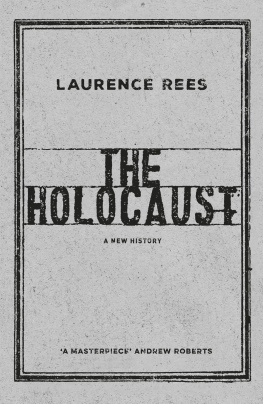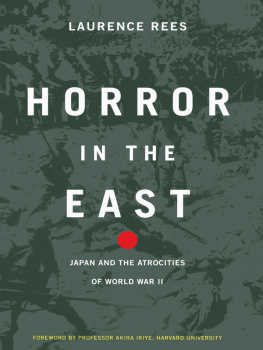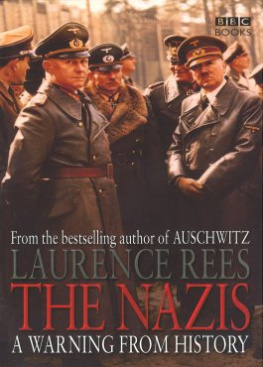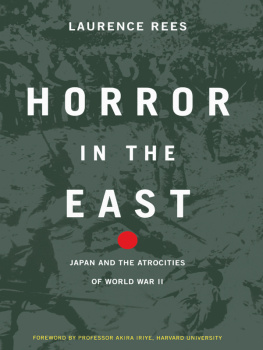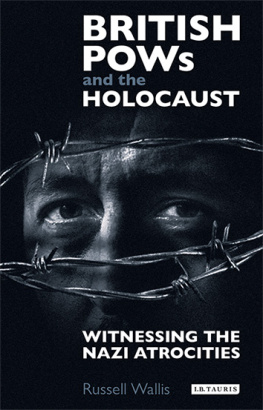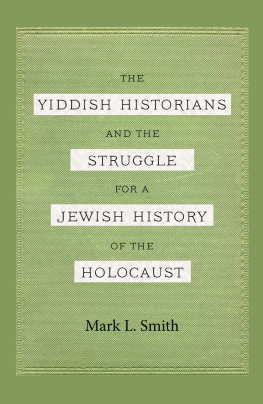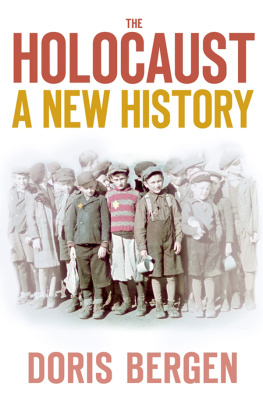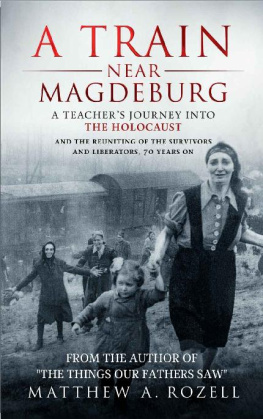Laurence Rees
THE HOLOCAUST
A New History
PENGUIN BOOKS
UK | USA | Canada | Ireland | Australia
India | New Zealand | South Africa
Penguin Books is part of the Penguin Random House group of companies whose addresses can be found at global.penguinrandomhouse.com.
First published 2017
Copyright Laurence Rees, 2017
The moral right of the author has been asserted
ISBN: 978-0-241-97995-2
To Camilla
List of Maps and Illustrations
Maps
Illustrations
SECTION ONE
SECTION TWO
SECTION THREE
(While every effort has been made to contact copyright holders, the publishers will be happy to correct any errors of omission or commission.)
Prologue
To the Nazis, Freda Winemans crime was simple. She was Jewish. In May 1944, at the age of twenty, she was arrested in Saint-Etienne in France by collaborators belonging to the paramilitary Milice. Together with her parents and her three brothers she was taken first to the notorious holding camp at Drancy in the suburbs of Paris and thence to Auschwitz Birkenau in Nazi-occupied Poland.
In early June 1944, the train carrying Freda, her family and nearly a thousand other Jews from France passed under the red-brick guardhouse of Birkenau and down a railway line directly into the camp. As the doors of the freight wagon opened and they emerged into the light, Freda thought she had arrived in Hell. The smell! The smell was awful! But Freda was still unaware of the true purpose of Birkenau. The place was huge and teeming with prisoners. Perhaps the new arrivals would all be put to work?
As she and her family stood on the area by the side of the railway track known as the ramp, events took an unexpected turn. Prisoners from a special unit called the Sonderkommando, dressed in pyjama-like uniforms, shouted out to the new arrivals, Give the children to the older women. As a consequence, Fredas mother was handed a baby by a young mother in her twenties.
The Jews were told to form two lines on the ramp men in one and women and small children in another. Bewildered by what was happening, Freda joined the line for women together with her mother who was still holding the baby. When her mother reached the head of the queue, an SS doctor Freda believes it was Dr Mengele told her to go with the baby to the right. Freda followed her mother, but then, she recalls, Mengele called me back, and he said, You go to the left. And I said, No, I wont. I wont be separated from my mother. And he said, in a most natural way, Your mother, she will be looking after the children, and you will go with the young ones [that is, the younger adults].
Freda couldnt understand why we were separated. I couldnt understand why they had to give the babies to older women. My mother was only forty-six years old. I couldnt understand what was happening, it was too quick. It was all happening so fast.
As Fredas mother walked away with the baby, her father and three brothers reached the head of their queue. All of them were told to stay together. But as they stood on the ramp, Fredas eldest brother David saw their mother moving off in another direction and thought that their youngest sibling, thirteen-year-old Marcel, should go with her. He reasoned that it might be easier for Marcel if his mother was able to look after him. So David told Marcel to accompany her and Marcel, listening to the words of his elder brother, ran off to join his mother. Unwittingly, David had helped send Marcel to his death.
They did not know it at the time, but they had just participated in a selection process in which SS doctors, in a matter of seconds, decided which person should be allowed to live temporarily and which person should die at once. The great majority of people on this transport were selected to be murdered immediately in the gas chambers of Birkenau including Fredas mother, along with the baby that had been placed in her arms. The Nazis did not want children, the old or the sick to last more than a few hours in the camp.
Freda, her father and her three brothers had been selected to work. Though the Nazis intended all Jews to die eventually, this was at least a postponement of execution. So by sending Marcel towards their mother, David had ensured that he joined the group that had been chosen to die at once. Marcel, as a thirteen-year-old, was borderline for selection and so the SS must not have cared if he went with his mother to be murdered. As Freda says, Davids actions would have been the right thing [to do] in different circumstances. But, amid the inhumanity of Auschwitz, it was the wrong decision.
On the ramp, the Sonderkommandos had told the young mothers to hand over their babies because the only chance they had of surviving the initial selection was to appear in front of the SS doctor without their children. Even if a mother was young and fit, the SS would rarely try and separate her from her child during the final selection process for fear of causing panic among the new arrivals. Members of the Sonderkommando had taken a look at Fredas mother as she waited by the train and decided that she was too old to survive selection. Since she was certain to die, and since the baby was also sure to perish, both had been placed together. That way the young mother had the possibility of living for longer than this one day.
How could such a situation ever come to exist on this earth? How could standards of common decency and morality have been inverted so unspeakably that the compassionate gesture of a brother directing a sibling to be with his mother helped cause his death, and the only chance a young mother had of surviving more than one day was for her baby to be taken from her and murdered?
More broadly, what were the reasons the Nazis decided to exterminate an entire group of people? Why did they take millions of men, women and children and gas them, shoot them, starve them, beat them to death kill them by whatever means possible? What was the place of this genocide amid the catalogue of other horrors that the Nazis were responsible for?
For twenty-five years I have thought about these questions as I wrote and produced a number of television documentary series about the Nazis and the Second World War. In the course of my work I travelled to many different countries and met hundreds of eyewitnesses from the period including those who suffered at the hands of the Nazis like Freda Wineman, those who watched events as bystanders, and those who committed crimes as perpetrators. Only a fraction of the testimony gathered for my films has ever been published before.
The Holocaust is the most infamous crime in the history of the world. We need to understand how this obscenity was possible. And this book, drawing not just on this fresh material but also on recent scholarship and documents of the time, is my attempt to do just that.
1. Origins of Hate
In September 1919 Adolf Hitler wrote a letter of immense historical importance. But at the time no one realized its significance. Thats because the Adolf Hitler who composed the letter was a nobody. He was thirty years old, and yet he possessed no home, no career, no wife, no girlfriend, no intimate friend of any kind. All he had to look back on was a life filled with crushed dreams. He had wanted to become a famous artist but had been rejected by the artistic establishment; he had longed to play a part in a German victory over the Allies during the First World War, only to witness the humiliating defeat of German forces in November 1918. He was bitter, angry and looking for someone to blame.

